Big M’s mysterious and forgotten ‘58 400-hp 3×2 Super Marauder makes a big comeback.They call Mercury “The Big M”. Who are we to argue? This incredible ’58 Monterey, though the lightest in that year’s lineup, tips the scales at over 4,000 pounds, packs a big 430 CID V8, carries a monumental factory rating of 400 hp, and has a trio of Holleys for carburetion. Amazing?
Yes, but even more amazing is how this milestone Mercury has managed to slip through the musclecar hobby’s cracks. How could we have forgotten so completely about a car with these stellar credentials?No car in the 1950s made more horsepower – none of the first-gen Hemis (peaked at 390hp), the 3×2 Caddy (345hp), supercharged Ford 312 (300hp, 340 in NASCAR trim), fuelie Chevys (290hp in Corvette), Impala 3×2 348 (315hp), or J-2 Olds (312hp). All those proud and renowned names are second place or lower. Alone at the summit of Mount Horsepower in the 1950s was the M-E-L (Mercury, Edsel, Lincoln) 3×2 430.
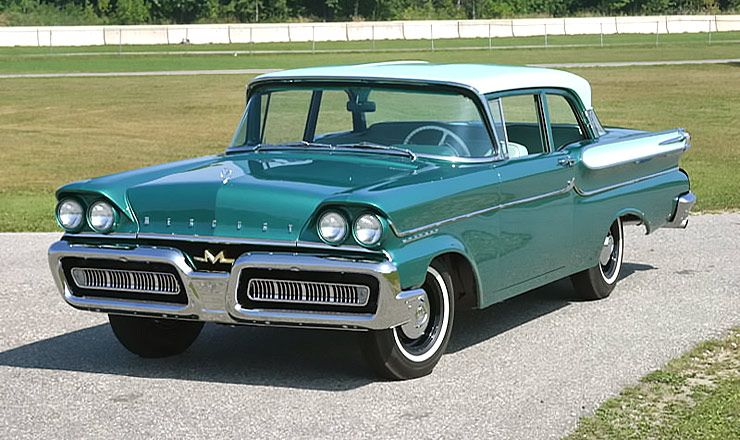
One Detroit native that managed to remember it is Brian Stefina. Brian had a ’54 Ford back in his high school years. A family friend offered him a no-cost 430 Lincoln engine. After a bit of driveway engineering, the 430 went to work in the ’54, livening up the party. The friend also happened to mention that Mercury had offered an obscure 3×2 option the 430. That curious bit of trivia stuck with Brian and would surface in later life in an unlikely way.
“I’ve been going to the Pure Stock Drags now for nine years,” he tells. “The first car I took there was a Corvette, and I liked that it was different.” Brian quickly developed a reputation for winding out the little dual-quad 283/four-speed, but after running it for several years, it was time for something else.
“That’s when I did the ’64 Marauder with the 427. After I’d run it for awhile, I wanted to do something else different and I wanted to do a ‘50’s car. I was thinking really hard about putting my ‘Vette engine in a ’57 Chevy, but I figured, ‘all that’s going to do is add more weight and be less aerodynamic.”
Slowing down is not Brian’s normal course of action. As he pondered the available engines from the 1950s, he couldn’t forget the 430 3×2 his family friend spoke of years earlier. Then fate stepped in. At a swap meet in Milan, Michigan, Brian came across a 3×2 intake for a big-block M-E-L engine.
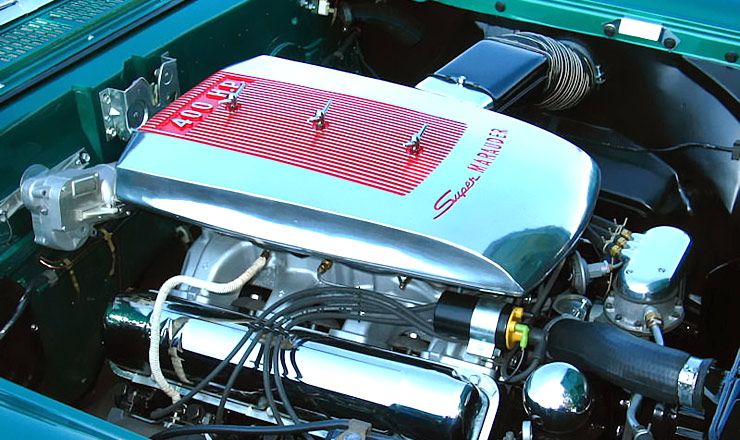
“I knew what it was because I knew that they offered it, and I ended up buying it.”
“Then I called up [Pure Stock Drags organizer Dan] Jensen and said, ‘Hey, I’m going to buy this intake because I want to build a ’58 Mercury with the 400-horse Super Marauder.”He said, “400 horse?”I said, “Yeah.”He said, “What year?”I said, “’58.”He said, “What size engine?”I said, “430.”“What horsepower?”“400 horse.”“In 1958?”“Yeah.”“Well, I don’t know if that’s a musclecar.”“I said, ‘I’ll tell you what, this is the biggest-displacement, highest factory rated horsepower of any engine in any passenger car in North America during the 1950s. In the sales brochure it says, ‘For the ultimate in performance.’ You can get this engine in any Mercury in the product line. I told him, ‘If this is not a ‘50’s musclecar, I don’t know what is. He kicked it around and said, ‘You’ve convinced me.”
The deal was on. Next, Brian began networking and found a breather in California. As you might imagine these parts are almost impossible to find. If the breather looks like it comes from a different gene pool, it does, as does the fuel pump case. The June 1958 issue of Motor Life explains why:
“An interesting sidelight is the fact that the unusually good-looking air cleaner and fuel pump casing were designed by Lynn Wineland of Motor Life companion publication, Rod and Custom.”
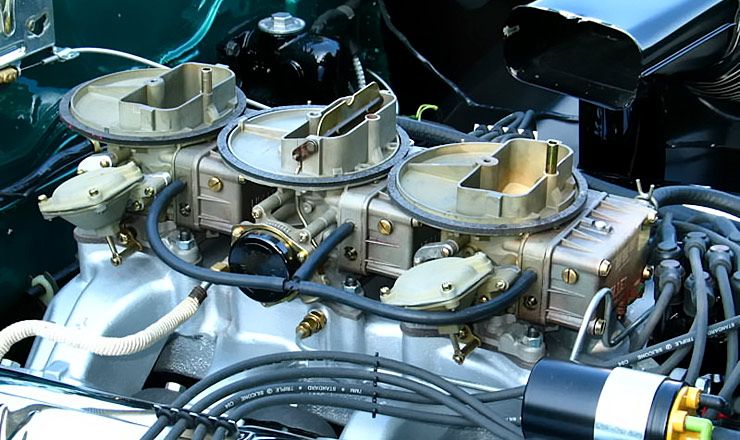
Underneath are a trio of Holley 2300 two-barrel carbs, to our knowledge the first use of three two-barrel Holleys. Previous 3×2 setups used Rochesters, Strombergs, or other makes. Brian had the extraordinary good fortune to have a co-worker who once worked at Holley and had drawings of the carburetors. The outboard Holleys operate by vacuum diaphragms. They draw air from behind the front grille. Brian left the manifold unpainted to show the aluminum casting. The factory finish would have been black.The M-E-L block is unique and not related to the more common FE series, though both are deep-skirt designs.
“The biggest difference between it and the FE,” Brian explains, “is that the bottom of the head is flat and the combustion chamber is in the block. The deck is at a 10-degree angle to the cylinder bore centerline.”Valves, especially for a 1950s engine, were huge, at 2.15 intake and 1.77 exhaust. Brian had the heads tested on a flow bench, and surprisingly, they flowed better than his ’64 427 Marauder heads.Other engine details are conventional — hydraulic cam, shaft-mounted rockers, cast aluminum pistons and 2-bolt mains. Exhaust manifolds are ram’s horn style, reminiscent of early small-block Chevrolets.Transmission choices were the old cast iron Merc-O-Matic, or a column –shift 3-speed manual. Brian went with the stick. It differs from the Ford gearbox in that it has bigger shafts and gears.
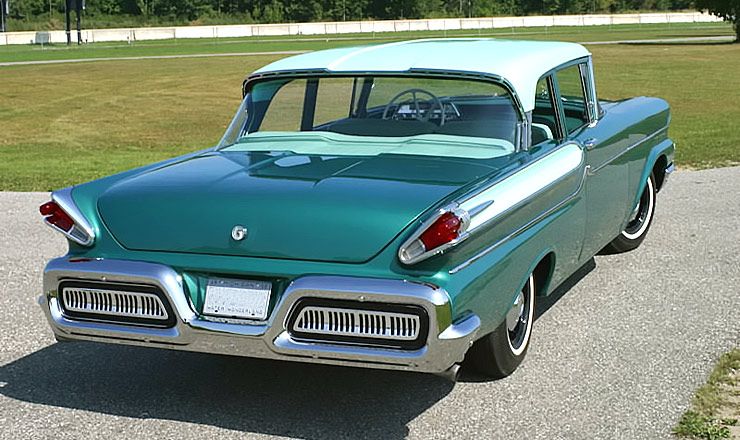
Through the same network of Mercury enthusiasts that produced the breather, Brian found a clean, West coast ’58 Monterey body and bought it, along with a couple parts cars to supply the various bits and pieces — seat valance, rubber door handle gaskets and window seals, electric wiper motor (a rare option), etc. — that are on the verge of extinction.
Brian disassembled the body, then took it to restoration ace Scott Tiemann in Portland, Michigan for his special touch. Ditto the frame. A quintessential ‘50s color scheme, Holly Green with Parisenne Green accents, was chosen.
Brian built the engine (it dyno’d at 420hp @ 5500 rpm), axle, chassis, and freshened up the factory heavy-duty Borg-Warner 3-speed. He got original seatcover material from SMS Auto Fabric in Oregon, and a friend’s wife stitched it together. He pieced the exhaust system together and had it finish welded, then coated. Brian used NOS parts in key places like taillights, trunk medallion, lenses, electrical switches, valve covers, and front grills and rear bumper inserts. All optional extras like heater, clock, and radio were deleted.
As the finished product took shape, it was clear that this was going to a very special car. It debuted at Detroit’s Autorama, an indoor show in Cobo Hall, where Motor City’s hardcore car enthusiasts did a collective head scratch. A steady stream of people filed by and stared in wonderment, only to return with friends who did likewise. Not surprisingly, it won 1st Place in the 58-65 Restored class.
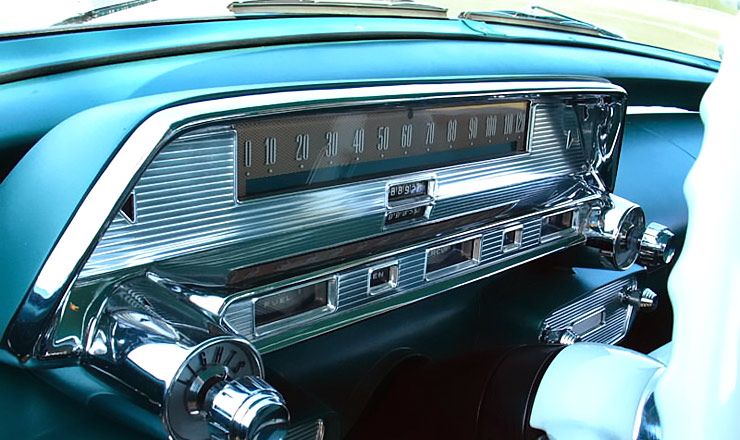
“What surprised me is how little this whole thing was known. I thought it would dumbfound a few people, but it really caught a lot of people off guard. I have friends in their 60s, and they’ll say, “You know, I thought I knew Fords but you pulled one on my.”
But Brian built the car for another event — the Pure Stock Drags. Crowds in the motel parking lot the night before got a sneak peek. In the sunlight at the track Friday morning, the mighty Merc was stunning.
A leisurely shakedown pass to make sure the car drove straight and the brakes worked produced a 15.17 second ET. From there Brian worked the Merc down into the 14s, but had his work cut out for him trying to launch the 4,264 pounder on super skinny 8.00 x 14 tires. Finessing the 3-on-the-tree shifter also some practice.
By Saturday afternoon, Brian had been pitted against a 350hp ’70 Chevelle SS396 with a 4-speed. In Round One, the Chevelle got the jump, but by the 60-foot mark, Brian grabbed it all back and then some. From there Brian let the big-cube Merc wind out against its 4.56:1 axle. When the two-toned Merc flashed through the traps to take the win light, a roar went up from the stands. With his unknown, unproven warrior, Brian had just knocked off one of the most popular musclecar icons.
Round Two held good news. And bad. Brian cut a wicked .030 light then jumped out to a decisive lead. This one was all Mercury. Brian shut out the Chevelle with a blazing 14.07 @ 100.40. The bad news was that, as an anti-sandbagging rule, the Pure Stock Drags disqualifies anyone running 3-tenths faster than their qualifying time. So his best ET was also his ticket out.
He’ll be back of course. Brian understands and appreciates the challenge of the Pure Stock Drags, and feels like the car should do 13.80s. There were plenty of faster cars, but this year he stole the show and was clearly the crowd favorite. His only real dilemma now is what to do for an encore.








